Rosewood History
Miners at the pithead of a coal mine at Walloon, 1890
Photo: Rosewood Scrub Historical Society
Coal Mines in the Rosewood District
Links
Walloon Coal Mine – Report from the “Week” – 1879
The Minutes of Rosemount Colliery 1937-1940 – Courtesy of Spencer Yarrow
The minimum wage rates for employees in coal mining industry – 10th January 1955
The Last Ipswich Coal Miner – How the Roughrigg Mine opened on the northern slope of Perry’s Knob. – Ipswich First
Map of coalfield – Queensland Department of Mines 1960
Ipswich & Rosewood Coalminers Memorial | Monument Australia
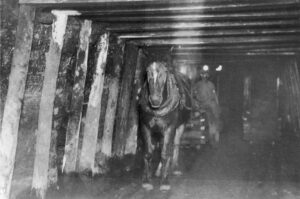
Pit Ponies were used to pull coal wagons where height permitted in the local coal mines.
The photo above was taken in 1920 in Q.C. Gauchalland Mine. (Maryborough Fraser Coast Regional Council)
LIST OF COAL MINES
If you can assist with information about this list, please contact me.
Amberfield – Amberley – 1948 -1955 Rylance Group
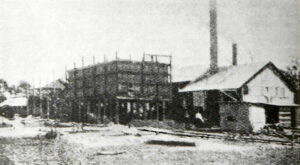
Caledonian – Thagoona Mine
Ardarth – 1931-1938 Lanefield
Caledonian- Walloon – John Rea’s Shaft – 1888 (Rea Seam) 1.5 metres thick, and in three sections. By 1900 it was in the hands of John Wright and his partner William Black and the manager was Charles Williams. In 1903 Arthur Boughen was the manager.
Caledonian No 1- Thagoona 1925 -1928
Caledonian No 2 – 1925-1947
Caledonian No 3 – 1931-1951
Caledonian No 4 – 1943-1950
Caledonian No 5 – 1940-1966
Caledonian No 6 – 1960-1966
Caledonian No 7 – 1960-1966
Clarefield Colliery 1924-1928 Thomas Burnside – Half a kilometre west of where Moorlands mine had operated briefly in 1877, on the south side of the Ipswich to Rosewood railway line.
Clarefield Colliery No 2 – 1937-1930
Clarefield Colliery No 3 – 1946-1950
Clarkfield – Thagoona/Walloon
Clydebank – Walloon – 1921 It closed three years later after another tunnel had been driven and was probably little more than a prospecting operation.
Clydebank No 2, No 3, No 4 – Walloon
Clydebank No 5 ( Westvale) – Lanefield
Commonwealth Colliery Limited – 1903 – Robert Sharp
The intention was to work the same seam as at Moorlands but on the northern side of the railway line. Sharp drove a tunnel to the seam, machinery was purchased and a siding was surveyed, but little more was achieved before the company went into liquidation.
Duckenfield – 1925-1928 – 200 meters west of Westvale Colliery No 2, Lanefield.
1927 – A sports gathering was held in St. Brigid’s School grounds on Saturday afternoon, December 17, organised in aid of Miss Eileen Potts’ candidature in St. Brigid’s Queen Carnival. There was a very good attendance. The chief event of the afternoon was a tug-o’-war, which attracted five teams – Duckenfield Colliery, Caledonian Colliery, Glencoe Colliery, Rosewood Farmers, and Rosewood Sawmill. After some keen struggles the final was fought out between Duckenfield Colliery and Caledonian Colliery. After 15 minutes the judge stopped the contest, and declared it a draw. Duckenfield was represented by Messrs. J. Clement, H. Embrey, J. Uprichard, D. Berlin, C. Yarrow, W. Federer, and W. Embrey. The Caledonian team was Messrs. E. Roberts, A Wright, S. Trewick, W. Buckle, J. McNamara, E. Bell, and P. Bell.
Edenbank – 1920 – John Hardie opened a small tunnel mine on a low spur of Perry’s Nob east of Rosewood – abandoned in 1925
Excelsior – 1912 – North Rosewood – Henry Harris
Harris sank a shaft to the Butler Seam for the Ipswich and Rosewood Coal and Coke Company Limited, and laid a tramway to bunkers which he built by the railway line 600 metres away. He took on nine hands and the company circulated optimistic reports about the prospects for their Excelsior Mine. Then Harris suddenly announced that coal production could not commence until a siding had been laid to the railway line. A fortuitous fire destroyed the engine-house and some of the machinery. Harris dismantled the other structures, and the company quietly abandoned the project.
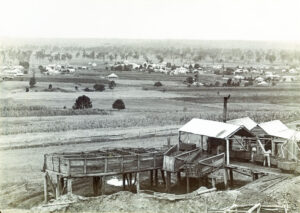
Glencoe Mine early 1920’s
Glencoe No 1 – 1904 – North Rosewood – John Hall (Halls Proprietary Limited) Leased by James Mitchell Bruce (1.2 to 1.5 metres thick, and in three sections). Hall closed the mine about 1908 until such time as the Rosewood-Marburg branch line would be finished, using the intervening time for driving a second (or No.2) tunnel to the seam and building coal bunkers ready for a siding.
Glencoe No 2 – 1911- The mine reopened in 1911 with Alexander McLean as manager.
Glencoe No 3 – 1915-1920
Glencoe No 4 – 1921
Glencoe No 5
Glencoe No 6
Glencoe Extended – 1960-1963
Glencoe Extended No 2 – 1962-1969
Queensland Times, Thursday, 7 August 1952 page 2
Mine Closed at Rosewood. Workings at the Glencoe Colliery Rosewood, which were closed on Monday because of fire, have been sealed off and the tunnel will be abandoned. Some of the miners employed at the pit have received dismissal notices, the Assistant Secretary of the Q.C.E.U. (Mr. R. James) said yesterday. According to union records 25 members are employed at Glencoe. A number of these will be retained to start a tunnel for a new mine and to work on an air shalt. The new tunnel will be driven about 40 yards to the coal seam. It will be reached from the same pit-top as the old workings, but will run at a different angle. Several seams have been worked at Glencoe since the pit was opened about 1904.
Gowrie Fern Mine – 1923-1925 – 200 metres south of Clydebank.
Haigmoor joined with the three Rosewood Collieries and operated until 26 May 1979.
Jeebropilly Mine – 1982-2019 – Amberley – New Hope
Lanefield No 1 – 1918-1927 – Situated on O’Donnell’s land
Lanefield No 2 – 1921
Lanefield No 3
Lanefield No 4
Lanefield No 5 – Lanefield
Lanefield Extended – Lanefield
Lanefield Extended No 2 – Mt Walker Rd, Rosewood
Lanefield Extended No 3 – 1945-1954 – Ebenezer
[In February 1928 The proprietors Lanefield Collieries had light tramway laid down from the colliery to the Lanefield railway station, a distance of about three-quarters of mile. Prior to this horse power had been used for haulage and the colliery had to suspend work during any wet weather owing to the roads being untrafficable.]
Little Jim – 1918 – John Mitchell Bruce sank a shaft near the old Commonwealth Colliery east of Rosewood at Lanefield. By 1924 tunnel was in full production. (1.5 metres thick in two sections)
Little John – Rosewood
Lowfield No 1 – 1925-1948 – Wass brothers – Lanefield
Lowfield No 2 – 1938-1951- North Rosewood
Malabar – 1929 – Marburg Just north of Roughrigg Collieries, near Mountain Ash No 2.
Malabar Nos 1-10
New Malabar No 1, No 2 All closed 1955
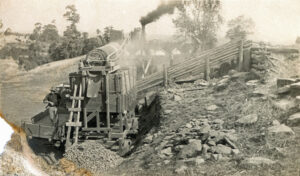
Normanton Colliery No 1
Moorefield No 1, No 2 – Walloon
Moorefield No 3 – Amberley
Mooreland Coal Pits – 1876 – Messrs J. & J. Moore – Rosewood Abandoned in 1878.
Mountain Ash No 1 – 1924-1928 – Mountain Ash Collieries Limited – Tallegalla.
Mountain Ash No 2 – 1929-1932- North face of Perry’s Knob.
Mountain View No 1, No 2 – Tallegalla
New Mountain View – 1945-1949 – Tallegalla
Mt Elliott No 1 & No 2 – Amberley
Mt Elliott Extended No 1 – Amberley
Neath No 1, No 2 – 1949-1956- Langtons Road
Normanton Colliery No 1 – 1922-1974 – Rosewood – Two local families, the Boughens and the Trewicks, opened a little mine a few hundred metres east of Edenbank in 1922.
Normanton Colliery No 2 – 1947-1954 – Mt Marrow
Oakleigh – Perrys Knob – absorbed the Glencoe, Perry’s Nob and Mountain Ash mines.
Oakleigh No 1 – 1928-1948
Oakleigh No 3 – 1948
1948-1999 – Oakleigh Colliery Company began business in 1948 when the Rule family acquired the operation. In November 1973 an open cut mine opened.
Oakleigh No 4 – 1961-1967
Oakleigh No 5 – 1984-1999
Oakleigh No 6
The New Oakleigh Open Cut – 1999-25/01/2013 – Rosewood. Owned by New Hope.New Hope acquired New Oakleigh from Sumitomo Coal in 1999. The mine closed down all mining activities at the site to focus on rehabilitation work. The reason for the closure was that the mine ran out of coal.
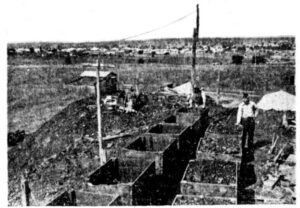
The pit-head of Rosemount Colliery overlooks the town of Rosewood.
Rosemount No 1 – 1931-1934 – Perry’s Knob
Rosemount No 2 – 1934-1940 – In May 1934 a new tunnel was being driven north of Glencoe Colliery at North Rosewood. Proprietors:- E. W. Richardson, C. W. J. Richardson, F. Yarrow and D. A. Berlin. Certificate of Application
Rosemount No 3
Rosemount No 4 1939-1969 – Mt Walker Road. Payslip
Rosewood Colliery – 1904 – Launched by William Andrews, Thomas Murray and Will Haenke. The company financed the sinking of a shaft south of the railway line some 200 metres east of Rosewood railway station, but the thin seam it reached proved unworkable and Haenke was authorised by his partners to liquidate the company.
Rosewood Colliery No 1 – 1929-1951 (Hardie Seam 1.2 to 1.5 metres thick, and in two sections)
Rosewood Colliery No 2 – 1940-1971 – (John Seam 1.5 metres thick, and in two sections) Closed 1971 and joined with Normanton and United No 8 as one company.
Roughrigg – 1913 – The Cochrane family started Roughrigg Colliery on their property
Roughrigg No 1 – 1927-1958 – Perry’s Knob
Roughrigg No 4 – 1939-1949
Roughrigg No 5 – 1955-1969
Roughrigg No 7 – 1949-1966
Smithfield No 1 ? -1942
Smithfield No 2 ? -1956 – Ebenezer
Smithfield No 3 ? -1965 – Ebenezer
United No 7 – 1944-1966 – Foot of Evan’s Hill, Tallegalla
United No 8 – 194? – 1972 – Perry’s Knob
Walloon Colliery – 1877-1887 – Smith and Levinge – Half a mile from the Walloon Railway Station. In 1879 the owners were Scott Smith and A. Meston, M. L. A until July 1880 when they dissolved their partnership. Sold to. Messrs. Callaghan and Co., of Brisbane. Messrs. T. and J. Johnson leased it.
In December 1879 they discovered a beautiful, rare and valuable fossil specimen in their mine. Karl Staiger, a well-known analyst and assayer, identified it as Araucaria, a conifer tree from the Jurassic period. It was lying on a fragment of bituminous shale, the interstices filled up with sand and dotted with mica scales, and it was lying as naturally and as perfect as when it was deposited there millions of years ago. They presented it to the Queensland Museum.
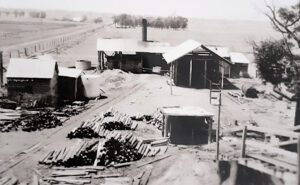
Westvale No 1
Westfalen – Thagoona
Westfalen No 1- 1932-1948 – Mt Marrow
Westvale No 1 -1913 – Perry’s Knob – Frank Gunthorpe and William Pearn
Westvale No 2 – 1918-1925
Westvale No 3 – 1925-1930 Closed at Perry’s Knob then opened Lanefield
Westvale No 4 – 1931-1938 – Lanefield
Westvale No 5 – 1943-1959
Westvale No 6 – 1941-1953 – Lanefield
Westvale No 7 – 1951-1954 – Lanefield
New Diesel Loco at Westvale Colliery 1951
